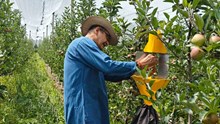
The story of Mukesh Garva, a young farmer from Fuldesher, a small village in the Lunkaransar tehsil of Bikaner District, has become an inspiration for thousands of farmers. Born into a middle-class family, he completed his B.Sc. and B.Ed. but has never been involved in farming since childhood. His family owned two hectares of agricultural land, where they traditionally cultivated peanuts and mustard. Traditional farming was costly and yielded very little. Production was dependent on the weather, and even a slightly abnormal rainfall or drought could destroy the entire crop.
At that time, his annual income was only 2 to 3 lakh rupees, barely enough to support his entire family. His financial situation was weak, and the family was also socially disadvantaged. However, today his annual income ranges from 30 to 40 lakh rupees. Let’s learn more about his success story.
Awareness and Innovation
Mukesh Garva decided to take advantage of his education and try something new in farming. He realized that economic prosperity was no longer possible through traditional methods alone. So he began attending training camps organized by the Agriculture Department, where he learned about modern farming techniques.
These training sessions gave Mukesh a new direction. He realized that with the right techniques and planned farming, even small areas of land could yield higher production and income. This led him to the idea of protected farming.
Technological Intervention: New Thinking, New Beginnings
1. Move towards protected cultivation (polyhouse)
With the support of the Agriculture Department, Mukesh installed three polyhouses, each measuring 4,000 square meters. He began cultivating cucumbers within these polyhouse structures. The key advantage of polyhouses is their ability to control weather patterns, allowing them to grow off-season crops.

2. Vegetable production and off-season farming
Along with protected cultivation, he also began cultivating off-season vegetables, such as tinda, ridge gourd, and cucumber. These crops are typically grown over a limited season, but through polyhouses and drip irrigation techniques, he made it possible to produce them year-round.
3. Water Management: Drip Irrigation and Rainwater Harvesting
Water is a major challenge in arid regions like Rajasthan. Keeping this in mind, Mukesh adopted drip irrigation. He also constructed a 118x118 feet deep pit, which is 15 feet deep. He collects rainwater from the polyhouse roof and uses it for irrigation. This eliminates water wastage and reduces production costs.
Current Situation: Mukesh Garva's hard work and technical understanding have transformed not only his fortune but also the thinking of the entire village and surrounding youth. Today, he earns between 30 and 40 lakh rupees annually, more than 10 times his previous income.

Effect of Polyhouse Farming
His three polyhouses produce 2,400 quintals annually, with an average market price of 2,500 rupees per quintal. Of this, production costs are approximately 18 lakh rupees, while total revenue reaches 60 Lakh rupees. This gives him a net income of 42 lakh rupees.
Social and Economic Impact
Mukesh not only improved his financial situation, but he has also become an inspiration for young farmers in his village. When he moved away from traditional farming and adopted polyhouses and modern techniques, many people considered it a risky move. But today, those same people come to him for advice.

His Contribution to Employment Generation
Mukesh’s farming now provides employment to local laborers and villages. Local youth find work in tasks like polyhouse, irrigation, crop management, packing, and marketing, increasing employment opportunities in the village.
















